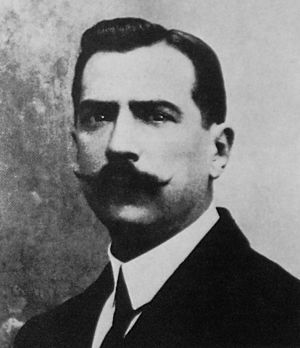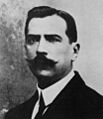Miguel Lillo facts for kids
Quick facts for kids
Miguel Lillo
|
|
|---|---|
| Miguel Ignacio Lillo | |
 |
|
| Born | July 26, 1862 |
| Died | May 4, 1931 (aged 68) |
| Nationality | Argentine |
| Awards | Francisco Moreno Prize, 1928 Doctor Honoris Causa |
| Scientific career | |
| Fields | botany, zoology |
| Author abbrev. (botany) | Lillo |
| Author abbrev. (zoology) | Lillo |
Miguel Ignacio Lillo (born July 26, 1862, in San Miguel de Tucumán – died May 4, 1931, in San Miguel de Tucumán) was an Argentine naturalist and professor. He was passionate about studying nature and made important discoveries about plants and animals.
Contents
Early Life and Learning
Miguel Lillo was born in the city of San Miguel de Tucumán in 1862. He went to the National School of Tucumán and finished in 1881. Even though he wanted to, he couldn't afford to go to university right away.
A Career in Science
Miguel Lillo loved science, especially learning about nature. After school, he worked as an assistant in the Physics and Chemistry labs at the National College.
By 1883, he had collected 700 different plant samples from his local area. He visited the National University of Córdoba to learn from experts like Federico Kurtz and the Döring brothers. They taught him a lot about how to classify (group) living things.
In 1888, he wrote an interesting paper about the plants of Tucumán. Soon after, he became an assistant to Friedrich Schickendantz, a chemist. Miguel Lillo took over his job in 1892.
In 1905, he published a book called Fauna Tucumana, Aves (Fauna of Tucumán, Birds). This book shared his discoveries of new bird species. At that time, he had the largest collection of birds from his home province.
In 1914, the National University of La Plata gave him a special award called Doctor Honoris Causa. This means "honorary doctor" and is given to people who have achieved great things. After teaching chemistry and physics, he started lecturing at the National University of Tucumán in 1914.
He was also chosen to be the director of the Museum of Natural History at the University of Tucumán. He became a member of the National Commission for Argentina's plants.
In 1918, he stopped teaching, but he remained the honorary director of the Museum of Natural History.
In December 1930, just before he passed away, Miguel Lillo gave all his property to the National University of Tucumán. This included land, money, a huge library, and his amazing collections of animals and plants. His plant collection alone had over 20,000 samples from 6,000 different species!
Because of his generous gift, the university created the Miguel Lillo Foundation in 1933. Miguel Lillo died in San Miguel de Tucumán on May 4, 1931.
What Miguel Lillo Did
Miguel Lillo was a very smart and observant naturalist. He was especially good at botany (the study of plants). But he also studied other sciences like chemistry and zoology (the study of animals).
He spent his time doing scientific research and teaching. He helped us learn a lot about the trees of Argentina. He also studied a plant family called Compositae. Miguel Lillo was also an expert in ornithology (the study of birds).
His interests weren't just in science. He also studied languages, including old classical writings and native languages.
He was skilled in phytogeography, which is the study of where plants grow. Between 1885 and 1916, he explored his home province of Tucumán. He also traveled a lot around Argentina. He went to Buenos Aires, Córdoba, Santiago del Estero, Cuyo, Santa Fe, and Salta. He even traveled to Chile in 1895. Other trips took him to Formosa, Chaco, and Mesopotamia, Argentina.
Honors and Legacy
Miguel Lillo received the Francisco Moreno Prize in 1928 for his important work.
Things Named After Him
Many places and things are named after Miguel Lillo to honor his contributions:
- The Faculty of Natural Sciences and Miguel Lillo Institute at the National University of Tucumán.
- The "Miguel Lillo Institute" and the "Foundation Miguel Lillo."
- A neighborhood in San Miguel de Tucumán called "Barrio Miguel Lillo."
- Miguel Lillo Park in Necochea, which is a public forest and nature reserve.
Plants Named After Him
Some plants have been named in his honor, including:
- The plant genus Lilloa
- Species like Chaetochlamys lilloi and Justicia lilloi
- Notholaena lilloi
- Matelea lilloana
- Juelia lilloana
- Lupinus lilloanus
- Desmodium lilloanum
Images for kids
See also
 In Spanish: Miguel Lillo para niños
In Spanish: Miguel Lillo para niños


